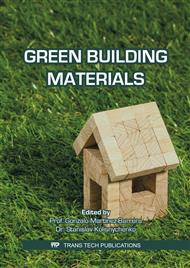p.51
p.56
p.61
p.66
p.71
p.77
p.83
p.89
p.103
Sustainable and Eco-Friendly Vege Roofing Tiles: An Innovative Bio-Composite
Abstract:
This paper presents a research study conducted on the usage of vegetable oil for the production of eco-friendly Vege roofing tiles. Conventional roofing tiles which constitute of concrete and clay are considered as environmentally unfriendly because of the significant amount of greenhouse gas emission during their production. An entirely novel methodology of utilizing catalyzed vegetable oil is proposed which can totally replace the use of traditional binders like cement and clay. Limited trails conducted on prototypes samples revealed that when catalyzed vegetable oil mixed with aggregates, properly compacted and heat cured at 190oC for 24 hours, have shown flexural strength up to 9.5 MPa. The superior strength gain of these prototype samples was considered due to the use of the catalyst with vegetable oil, which resulted in the initiation of catalytic oxy-polymerization set of reactions during heat curing, converting vegetable oil to solid, hard polymer which is considered responsible for strength achievement factor for these novel Vege roofing tiles. All prototypes samples were tested for performance indicators like water absorption, permeability, and flexural strength according to ASTM standards. Moreover, the susceptibility of oil leachate from the tiles oil, when tested using electrical conductivity method showed a negligible amount of the electrical conductivity. Moreover, the estimated embodied energy requirements for these tiles were found quite less when compared to conventional tiles.
Info:
Periodical:
Pages:
71-76
Citation:
Online since:
January 2017
Price:
Сopyright:
© 2017 Trans Tech Publications Ltd. All Rights Reserved
Share:
Citation:



